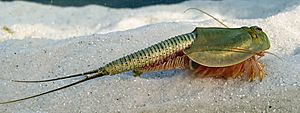Notostraca facts for kids
Quick facts for kids Notostraca |
|
|---|---|
 |
|
| Scientific classification | |
| Kingdom: | |
| Phylum: | |
| Subphylum: | |
| Class: | |
| Order: |
Notostraca
|
| Family: |
Triopsidae
|
| Genera | |
|
|
Notostraca are a group of small crustaceans often called tadpole shrimps. They look a lot like tiny horseshoe crabs and live in temporary pools and shallow lakes. There are only two main types, or genera, alive today: Triops and Lepidurus.
These amazing creatures are known as 'living fossils'. This means they look almost exactly the same as their ancestors did millions of years ago. Scientists have found their fossils from the Triassic period, which was about 250 million years ago!
Contents
Life and Habits
Tadpole shrimps are omnivores, meaning they eat both plants and small animals. They usually live on the bottom of their watery homes, sifting through mud for food. You can find them in pools of water on every continent except Antarctica.
They grow very fast, sometimes reaching their full size in just one week! However, they don't live very long. The oldest Triops ever recorded lived for about 100 days.
Amazing Eggs: Diapause
When the pools where tadpole shrimps live start to dry up, the adult shrimps die. But their eggs are very special. They can stop developing and go into a resting state called diapause.
These eggs can stay dormant, or "asleep," for a very long time, sometimes up to twenty years! When water returns to the pool, the eggs "wake up" and hatch. This amazing ability helps tadpole shrimps survive in places where water comes and goes.
Ancient History and Features
The fossil record for Notostraca is very detailed. We can find their fossils in many different rock layers, going all the way back to the Carboniferous period. This shows how long they have been around without changing much.
Long ago, tadpole shrimps used to filter food from open water. But over time, they changed to living on the bottom of muddy waters. They now eat tiny bits of sediment and hunt small animals.
Notostracans also have a unique feature: two separate compound eyes. These eyes touch each other but don't join together. This is an ancient trait that other similar crustaceans have lost over time.
Images for kids
See also
 In Spanish: Notostráceos para niños
In Spanish: Notostráceos para niños



